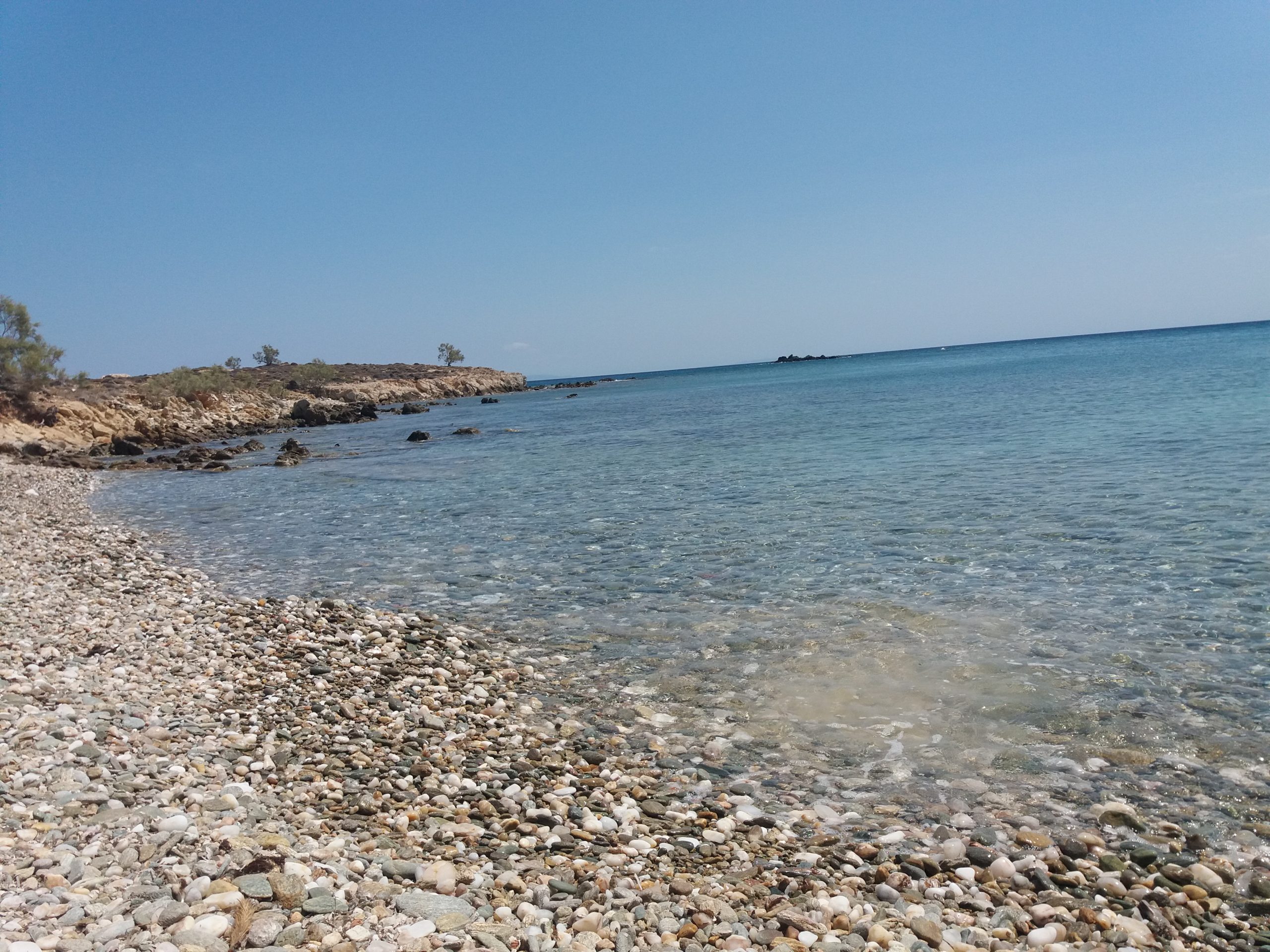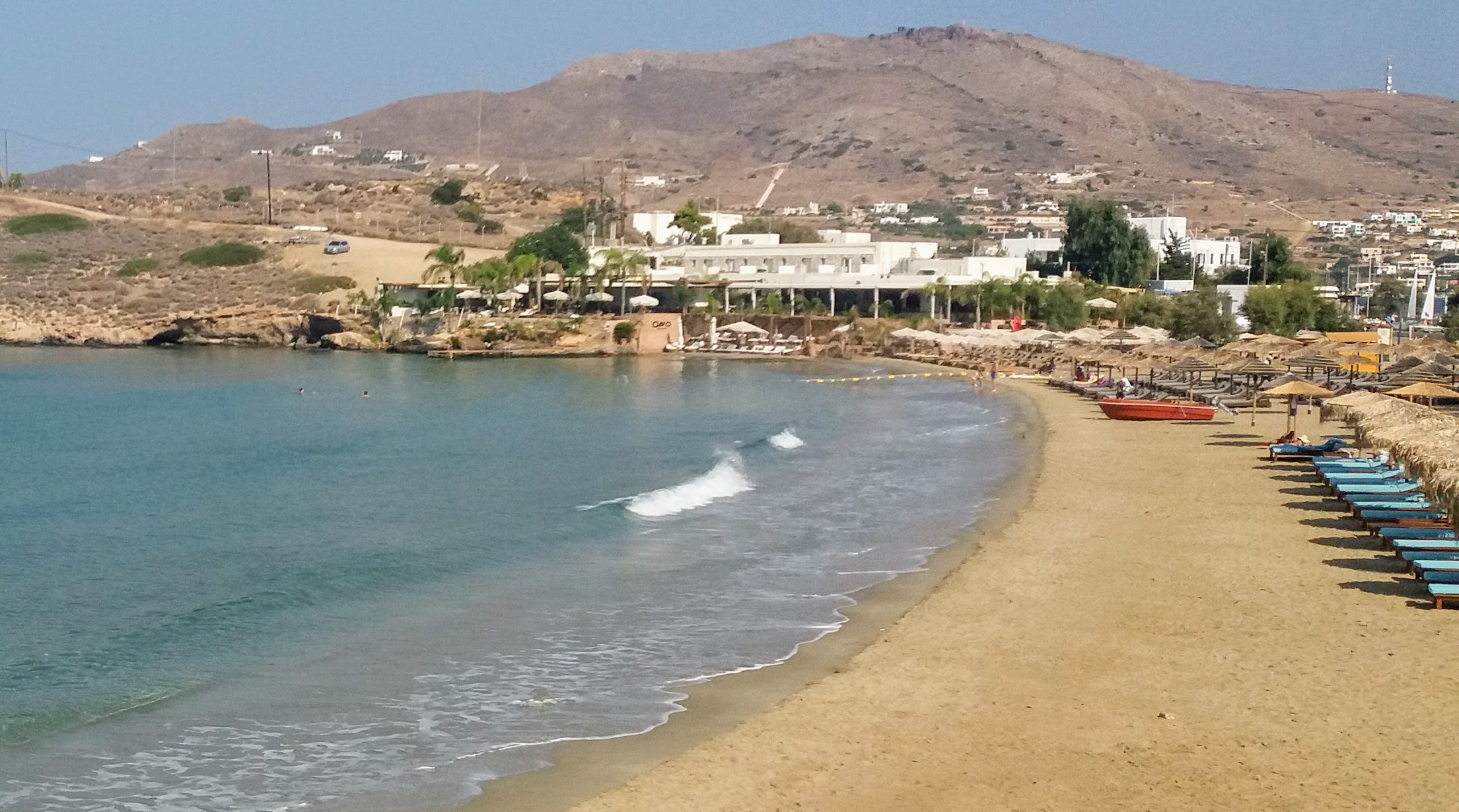It feels a bit like Greece has been riding an endless wave of heat since mid-May on Syros. Now that holidays are upon us and the bus timetable is in full swing let me take you on a round-the-island-guide to cooling off at the best places to dip, dine and dawdle by the sea! Let’s dive right in!
For the townies there can be no better place to cool off than in the magic waters of Vaporia. Think old-world glamour with sprawling neoclassical mansions perched on the water’s edge; once the place for wealthy sea merchants to build their houses it still retains a neat balance of history with chic international vibes. The swimming platforms at Asteria might be concrete but the beauty here is all natural as the sea twinkles a perfect blue while shoals of tiny fish dart under rocks. It’s deep too, making it perfect place for diving. Get here early to nab a spot under one of the umbrellas and rub shoulders with the locals who have been swimming here forever – some even have little cave stores and shaded huts, where waddling ducks and well-fed cats join bathers parading across the walkway.


Take yourself on a self-guided swimming tour past the pastel hued architecture – stone ruins of shipping warehouses jostle with fabulous restorations – all provide a balancing contrast to the blue dome of St Nikolas. For those in need of curated comfort with upscale drinks after their swim head further along to Ciel bar which is open day and night. If the steps are too much take a rest stop at Sta Vaporia for coffees and all day dining with views across the water. The newest opening here is the Hotel Aristide with nine magnificently elegant suites blending eco-design and luxury in a restored neo-classical mansion. Check out their chic rooftop bar for sunset cocktails.

First stop on the round the island bus beach tour is the small but perfectly proportioned Azolimnos. Here you’ll find a handful of bars and tavernas as well as sun loungers, cafe’s and a small convenience store. The small beach is sandy to the left and rocky to the right. It often has a prevailing breeze from the East in summer making it cooler and the sea a little wavy.
For those who want a little work with a reward, head right at the bus stop following along the road, past a small harbour of fishing boats. This turns into a walking trail that hugs the coast granting some great scenic views as well as interesting flora and fauna. Here you can find secret coves like Fokiatres perched under the cliffs, BUT this comes with a warning as parts of the path need cautious steps. Last month (June 2021) it looked like parts had land slipped over the winter, so use caution on paths and keep inland at a comfortable distance from the edge. Some coves and swimming spots need a scramble – so not for the faint hearted! After 20 mins walk from Azolimnos you’ll see Santorini Beach with a dirt track accessible by cars / mopeds. This is still fairly isolated but has a changing cabin and four parasols. But bring supplies as it’s still a good trek from any kiosks.

After Santorini, follow the same coastal path and you’ll reach Fabrika in under 10mins walk. It is a nice clear sand beach which is fairly shallow for children and on calm days brave swimmers can reach a little island with a miniature chapel on. It has a few parasol shades but no facilities or cafes. It’s a local kind of place where families staying close by meet up and can get crowded by late afternoon (which goes without saying for all Greek beaches in August!). Fabrika also has a tiny harbour for fishing boats.


From here a short walk will take you out to the headland at Katergaki. Not a beach in the typical sense but a dramatic rocky place to swim in clear water ideal for snorkelling and diving. Feels remote and wild, more like swimming in an extremely deep and clear lake when the water is calm. One of the unofficial-official nudist areas; but not intimidating and always mixed with all types of bathers.
Next up is Vari – which although being the biggest residential area on the island has a small beach with lots to offer; shallow waters, lifeguard patrol, disabled access and numerous bars and tavernas to choose from. It’s a bit pushed for space for those who don’t wish to have a sunlounger from one of the cafes. Head right next to the Vari Beach Hotel (now closed) to find a spot in the public section. But otherwise a great place to while away an afternoon.

Swim over to the jetty and boat house underneath the imposing Goulandris Mansion – built in the 1970s by the former owners of the Neorion shipyards in a slightly gaudy style of a castle. It’s a great place to practice dives – as all the children who congregate there in a competitive spirit will attest!
Next along the coast is Achladi linked by my unofficial award for ‘Best Pavement in Syros’. To walk here from Vari you get to enjoy the only uninterrupted pedestrian space on the island (or indeed the Cyclades?) It is brief at less than c.400 meters but extremely delightful for joggers, walkers, baby strollers and wheelchairs users. Just don’t expect it to lead any further than the turn to Achladi bay. The translation means Pear- which I guess describes the curvaceous scooped bay. It has one hotel, The Emily, a few sun loungers and the Achladi Taverna – all are pleasant and the water is calm for swimming. It’s probably the smallest proper beach so it can get easily crowded. But what is wonderful is that the headland opposite is wonderfully barren and rock strewn so feels wilder than others.
I have to confess I haven’t swam at Mega Gialos beach, but promise to rectify that soon. This area spreads out across the coastal road and its beaches are small shingle and sand beaches strewn with shade from tamarisk trees. I always think it has a kind of remote island feel. There are just a couple of summer taverna’s here – but nothing that makes it feel too resort-like or built up. Lots of locals swim here in the mornings and offer a laid back unpretentious vibe.

Round the next bay is Ambela – a small beach with just one simple Taverna. A classic swim spot to relax and then have lunch at the Ambela taverna. The area has been developed in recent years as more villas have been built on the headband and cars now park ridiculously close to the beach, but can still be fairly quiet in even in high summer. The steps down make it feel like a retreat as well as a reward after the walking effort.
I am assuming you are back on the bus – easy enough to hop from one beach to the next if you are armed with a timetable and a willingness for short adventures! To get to Agathorpes, you need to get off the bus after it stops at Poseidonia. Just when the bus heads towards the coast again, you’ll spot the Di Mare Hotel on your left and before the bus goes to turn left the driver usually yells ‘Agathorpes’ loudly as otherwise it’s easy to miss! Once off the beach you’ll see one of my favourite crumbling houses perched right on the harbour to the left of Fetouri beach (if anyone knows the history of this place, get in touch – it would have been spectacular once, right?)
Feuturi has a few shades and loungers belonging to the Di Mare Hotel, but if you want golden sand go to Agathopes. The beach has an expensive beach bar, Ono, which (to some) is a little too showy. Love it or hate it, make your own mind up. But what compensates for the over saturation of sunbeds is that the beach is actually wonderful golden sand and clear turquoise seas. Pitch up early to get space on the public side.


There are a couple of tavernas here and even more heading back towards Finikas and Poseidonia. Like many places Syros suffers upgrade-fever. It spreads like a ‘blandemic’ – symptoms include the over use of grey decor, white painted chairs and unimaginative pan-European menus. For something traditionally Greek try Meltemi, tucked above the little harbour and opposite the Naval Base, for classic freshly cooked dishes and simple, seasonal and delicious food.

Onwards from Agathorpes is Komito; get here by walking the road along the coast for under 15mins. Here you’ll find a tree fringed beach with a few shades and a beach cantina with watersports. Hidden someway back behind the fields are the decaying ruins of a magnificent residence once built by a wealthy shipping merchant, Count Diakiakis in the early 1900s. You can see some photos here on another blog – like many other mansions in Poseidonia (Delagrazia) they are of great architectural interest and I particularly adore that sense of decaying grandeur, emblematic of the island’s unique cultural and social history. I hear the Diakakis building is protected by the Ministry of Culture, but the site has been up for sale for an eye-watering amount for years. Of course it would be amazing to save the structure – but without public funds an investment of that scale comes with a cost, likely a resort development, unless done sensitively could risk the character and impact.

Komito, Sept 2020
From here there’s a decent 40min walk right across the headland to the lighthouse at Viglostasi, passing interesting rock formations and wild barren hills. The views from the tip of the cape where the lighthouse is perched are spectacular and you pass through ruins I imagine may have been the original stone built lighthouse or an ancient fort structure. And you might spot a daring smiley face painted on a rock…



Coming up in part two, explore the beaches of Finikas, Galissas and Kini.
Then onwards to Apano Meria and the wild north coast beaches of Varvaroussa, Aetos, Lia and Grammata.
Where is your favourite beach on Syros?











